Mangoes are more and more available at the local supermarkets here in Phoenix, and growing a mango tree from a seed is not very difficult. If you have the perfect climate and plenty of seeds, you can just stick them in the ground or a pot after finishing eating the mango and a significant percentage will grow. This pictorial tries to give you some pointers on growing them in a more controlled environment.
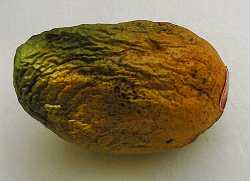
The old question we must first address is 'why growing a fruit tree from seeds when it would be so much better to buy a grafted one that would have known qualities and would fruit so much faster?' It is a valid point, but we won't worry about it. Growing mangoes in Phoenix are mild abnormalities, and you probably have as many chances in having a satisfactory crop on a seedling than you would have on a grafted mango. My personal choice is that I have a couple of grafted mangoes and plenty of seedlings.
Most mangoes are appropriate for using the seeds, although a stay in a refrigerator decreases drastically the viability of the seed. Keep your mangoes in a warm environment, they taste better anyway. This particular one was forgotten in the fruit basket. It is a Keitt mango, fairly big, almost no fibers and very sweet tasting. They are generally available toward the end of the summer.
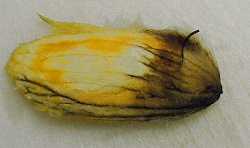 After eating the mango, clean the
seed as well as possible. This seed has very little fiber, so the
job was fairly easy. The seed dries pretty fast and has a very short
shelf life. Forgetting it for a couple of day on the side of the
sink is probably okay, but much longer will be a problem.
After eating the mango, clean the
seed as well as possible. This seed has very little fiber, so the
job was fairly easy. The seed dries pretty fast and has a very short
shelf life. Forgetting it for a couple of day on the side of the
sink is probably okay, but much longer will be a problem.
The seed has an envelope-shaped outside shell that has the
consistence of thick paper containing a tender bean shaped seed. The
problem at this point is to tear the shell without destroying the
seed. The best way I have found is to use strong scissors or a sharp
shear and cut the edge of the envelope on half the perimeter.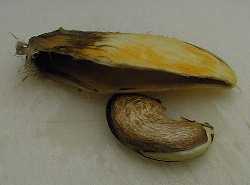 The goal of course is to remove as little
as possible to avoid damaging the inside. The third picture shows the cut
shell. What is not apparent on the picture is that less than 0.25
inches of shell has been removed.
The goal of course is to remove as little
as possible to avoid damaging the inside. The third picture shows the cut
shell. What is not apparent on the picture is that less than 0.25
inches of shell has been removed.
The next step is to put the seed in a warm and moist
environment. The air at Phoenix (or in many houses elsewhere on the
planet) is very dry, and controlling the humidity is essential. The
best way I have found is to use a zip-lock bag or something similar.
Write the content and the date on the bag, and then just put some of your
preferred potting soil, sand or other commercial mixture. Add some
water so it is barely moist. The environment should be as clean and
sterile as possible. I sterilize by keeping it in boiling water for
5 minutes or so, but you can probably skip this. Some fungicide can
be used as an extra precaution.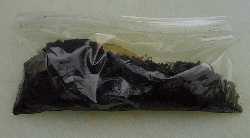
The seed is not dormant and starts growing immediately. It takes generally one to two weeks before the root shows up and start growing in the soil. it will take another 2 to 4 weeks before the stem comes up from between the cotyledons.
Depending on the size of bag and the quantity and type of
potting soil you used, you can wait more or less time before transplanting
the seedling. In this example, we used a small bag, and we need to
transplant it early.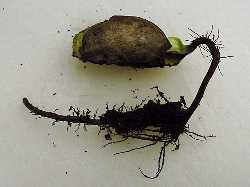
As it is, we waited a little too long, and the root is
already well developed and has started to crowd the bag. The early leaves
are fragile and needs to be protected from drying. We move the
seedling to a pot in another bag.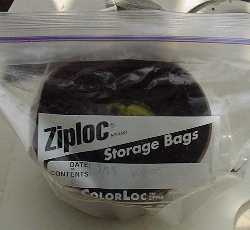
Again don't forget to label the bag properly. Some bags have areas specially coated so that you can use permanent marker or pencil. There is little more frustrating than having a nice seedling in one of the bags that has been there for several months, and not remember at all what it might be.
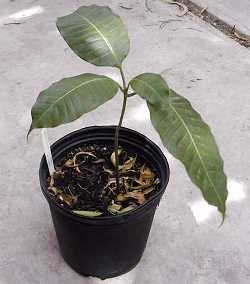
Mango leaves came in flushes, that is the bud unfolds into a 2 to 4 inches piece of stem with 4 or more leaves. After the seedling has had its first flush, you can start opening the bag and letting the humidity decrease. It is important to be careful during the week or so that the flush takes to mature. If the air or soil is too dry the flush will not develop and the seedling might die or be seriously delayed. Don't move it around, it should have bright light all day. Young seedling also must have soil continuously moist, not wet. Water them frequently, and make sure they are not standing in water. Seedling will drop their leaves if uncomfortable, and they generally don't have any to spare.
The last picture is 4 months after planting the seed. The seedling is now in a 1-gallon pot.